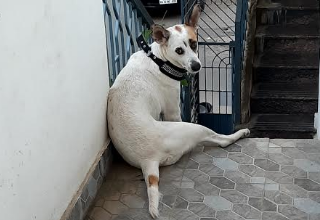Dogs have been man’s best friends and Indian dogs got domesticated thousands of years ago. Today we have a massive stray dog population in the country. Culling them is not a solution. An effort involving government agencies, NGOs and communities should help us assimilate our canine population into our society.
By Prathima.G.Kulkarni
Dogs have been domesticated for protection from a very long time. We can find stories of our furry friends in our mythology, which talk of their loyalty and bravery. One such story is that of a dog named Sarama who belonged to Lord Indra. He was chosen for a supreme task wherein he was sent to PatalaLoka (Underworld) to retrieve the cows that were stolen. It is said in Rig Veda that Sarama is the mother of all dogs.
Scientists consider the Indian pariah dog as the first truly domesticated dog. This species finds mention in the great Indian epic of Mahabharata. The closing chapter of the epic narrates the tale of King Yudhisthira and his brothers (The Pandavas) making a pilgrimage to their final resting place. It is said that after the great battle of Mahabharat between the Pandavas and Kauravas, Yudhisthira was feeling devastated as he had lost all of his cousins and relatives. He left the kingdom and went in search of heaven and was followed by his brothers, the Pandavas and wife. As they left they were followed by a dog that accompanied them throughout the journey. Only Yudhisthira and the Dog could make it till the gates of heaven.
A dog named Hachiko is very famous in Japan and is remembered for his loyalty and fidelity. Hachiko was a pet dog of Hidesaburo Ueno, a professor by profession in 1920s. Ueno would commute daily to work. Hachikō used to leave home to greet him when he returned every day near the Shibuya station. This was their daily routine until May 21, 1925, when Ueno did not return as he had suffered cerebral hemorrhage during his lecture and died without returning to the train station where Hachikō waited. Each day, for the next nine years, nine months and fifteen days, Hachikō awaited Ueno’s return, appearing precisely when the train was due at the station. Later, after the dog’s death the locals built a statue as a respect for the faithful dog.
In India, there are a lot of street dogs which are struggling to survive and go through a lot of trauma. They get to witness the bad things that humans do to them and to other humans as well. This causes them to be reacting differently as they are being treated wrongly. Most people complain and say that dogs are menace as they bite and bark while making the surroundings dirty.Dogs do not bite until they are provoked. Things like staring at into their eyes, hitting them with stick or stone, trying to move them by force will force them to bite. Children are not educated properly about dealing with dogs, which in turn makes them do the same things that they have seen their elders doing.
There are around 35 million stray dogs in India according to estimates by the World Health Organization. The population of street dogs in major Indian cities is as follows:
Kolkata: 80,000
Vijayawada: 16,000
Bengaluru: 300,000
Chandigarh: 12,900
Delhi :189,000
Mumbai: 100,000
Chennai: 185,000
These numbers look really large. Right? We need to know the reason as to why this is happening so that we can try to find a way to stop this and figure out what to do next.
- Our city corporations are terrible at managing garbage. Consequently the strays are getting to eat from this, survive and breed.
- We have a lot of bad dog owners who leave their pets on the street to survive.
- Our civic bodies are not doing their job of sterilizing the dogs properly under the Animal Birth Control Scheme.
- Humans have occupied the natural habitat of dogs and which has made them to live amongst us.
- There is no dedicated place for the dogs where they can live peacefully.
So is culling or killing them the only way out? We don’t think so. Culling or killing dogs is the most inhumane way to stop the ever growing population of the street dogs. Even relocating will not solve the problem the as new dogs will occupy that spot. According to NGOs such as CUPA, PETA India, our law believes in Animal Birth Control by sterilizing the dogs and leaving them in the same area where they used to live earlier. Sterilization is a very healthy and effective way to reduce the number of street dogs. A dog, which is sterilized, is less prone to be aggressive and is less likely to harm humans. Doing an animal census and inoculating the dogs prevents rabies.
Also, the dogcatchers from the municipality or NGOs are supposed to catch the dogs in a humane way without stressing them and the vans they are transported in shouldn’t be overly crowded. Once, the dogs are sterilized they are supposed to be left at the same location from where they were picked. The people who come to pick them up should make note of all the details of the dogs and they should be well trained to handle the dogs.
There are a few good things different cities are doing that will help better manage the street dogs so that then co-exist harmoniously. Humane Society International/India has entered into a memorandum of understanding with Lucknow Municipal Corporation (LMC) for an animal birth control project. The goal is to sterilize and vaccinate at least 15,000 dogs in Lucknow within a year.
The project will be carried out at the dog sterilization center developed by the LMC at Jarhara Indira Nagar Lucknow. The facility can house up to 50 dogs a day. A team of trained animal handlers will humanely catch street dogs and bring them to the center for sterilization and also vaccinate them against rabies. After treatment, the dogs will be released at the same locations from where they were picked up, in accordance with the Prevention of Cruelty to Animals Act, 1960.
In Indore, the residents of Old Palasia area have volunteered to help the street dogs in their locality/community by providing each dog with a unique name and a collar. This project is known as “Dogitization”. All the dogs will be treated as community dogs and a local resident will be in charge of feeding them daily. The dogs will be vaccinated and sterilized.
Another way which can help in reduction of the street dogs is by adopting them. So, what happens when you adopt a street dog:
- When you adopt, you are giving a new life to the dog and it will reciprocate your love and compassion. It will remain loyal and guard you and your surroundings
- You become responsible. When you know that a life is dependent on you, it will become your main focus to give a better life to the dog and be more caring.
- “A heart of the dog is as pure as Diamond”. If you’ve ever loved a dog, you’d know how insensitive it is to objectify them into status symbols. A stray dog will love you as much as a fancy Husky or a St. Bernard would, probably even more.
- All the foreign breeds are not accustomed to the Indian Weather. They tend to feel sick and it is not good to make a dog suffer. On the other hand our Indie dogs are living here from times immemorial and are accustomed to the weather here. They have built immunity and the cost of maintaining them is very less. Most of the vets also agree to this and say that the time and effort to care for a street dog is less when compared breeds from abroad.
- They’re out on the roads, with no certainty of the next moment. A car may run over them and nobody would know. Or someone might poison them, hurt them and throw stones at them. Is this what they deserve? Certainly not! What they deserve is a loving home.
- By choosing to adopt a homeless dog, you’re taking a stand against cruelty to animals by money-minting breeders. The breeders over breed dogs and make them suffer. These dogs are always kept in small cages and mostly under unhygienic conditions. It is time for us to step up and put an end to such torture.
- Street dogs roaming our streets are considered a nuisance by many. NO, they are not a nuisance. What we humans fail to understand is that they are protecting our streets at night and safeguarding us. They belong to the locality much more than we do. We are taking away their natural habitat by constructing buildings and this has led them to live on the streets.
- When we adopt a dog, we set an example for everyone and not just the dog lovers. You’re helping reduce the stray population. This is the change we need and this is the change that our community needs. If there are kids in house, there is no better way to bring them up than giving them the company of a dog. They will have a friend and a companion, which will help them in both physical and mental well-being.
Let’s now look at the laws that govern the street dogs:
1. It is not illegal to feed stray animals. Any person or animal lover shouldn’t be stopped or demanded not to feed the street dogs.
2. It is illegal to poison stray animals. This is the most inhumane thing to do and we have no rights to poison the dogs. They do have equal rights to live as much as we do.
3. It is illegal to cause harm to stray animals. Firstly it is very tough for any dog to live on the streets, as they have to go through so much trouble and be alert all the time.
4. Government issues IDs to people who feed stray animals.
5. It is against the law to relocate stray animals from their territory. Relocating strays to different territory will cause a major pain for the dogs as they will not be able to adjust to the new environment and will go through constant struggle.
6. It is illegal to deliberately starve street dogs or take away their shelter.
7. Capturing them against their will is against the law.
So, what the Government of India and the NGOs working for the welfare of street dogs should ensure is that all dogs live in peace in the localities they inhabit. This has to be done in all our cities and towns. They should employ enough doctors and doctor should be appointed and other helpers to attend to the dogs regularly. When it comes to providing food for the dogs the best solution is to contact hotels and restaurants so that the leftover food can be accumulated and given to these dogs. According to the United Nations Development Program, India wastes up to 40% of the food that is prepared. If proper arrangements can be worked out, this food can be used to feed our street dogs.












